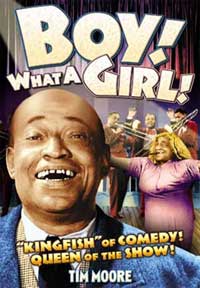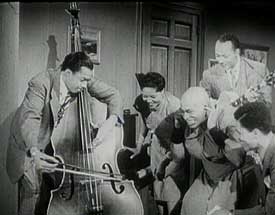 Behind the opening credits & carried over into the first scene of Boy! What a Girl (1947), the Slam Stewart Trio is performing a rather experimental piece of jazz centering around Slam's bowing of a double-bass together with his humming an octave higher than his instrument.
Behind the opening credits & carried over into the first scene of Boy! What a Girl (1947), the Slam Stewart Trio is performing a rather experimental piece of jazz centering around Slam's bowing of a double-bass together with his humming an octave higher than his instrument.
Slam also performed as "Slim & Slam" with Slim Gaillard, & their biggest hit was "Flatfoot Floogie with a Floy Floy." Slam performed with Art Tatum, Benny Goodman, Dizzy Gillespie, & many such.
His trio in this film has him supported Beryl Booker on piano & John Collins on guitar. Beryl had been a prodigy who taught herself the piano as a child in the midst of Philadelphia's African American musical renaissance of the 1920s.
Her first professional gig was as one-third of Slam Stewart's trio, but she went on to cut a half-dozen specacular albums of her own, as pianist, vocalist, & even as the leader of the all-women Beryl Booker Trio.
Beryl was the pianist for such phenomenons as Billie Holiday & Dinah Washington. But for incomprehensible reasons, she was all but forgotten by the 1960s, though still performing in obscure bands. She has yet to have the complete revival her jazz contribution merits.
John Collins has fared much better in the jazz histories which cite him numerously among the great jazz guitarists of the greatest era of jazz, having backed Billie Holiday & played with Lester Young & for a long while with Nat King Cole.
So when we listen to this trio in Boy! What a Girl, we're being treated t to genius. Besides the unusual instrumental that opens the show, they'll later be seen on a jump-jazz number "Oh Me, Oh My, Oh Gosh," written & sung by Slam.
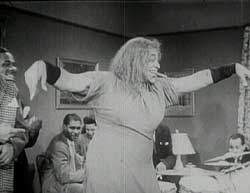 This film has long been underestimated, with one reference book on jazz in the movies dismissing it as a "weak black cast comedy," allowing only that some of the music is good. As point of fact all the music is good, but it's also pretty damned good for its comedy.
This film has long been underestimated, with one reference book on jazz in the movies dismissing it as a "weak black cast comedy," allowing only that some of the music is good. As point of fact all the music is good, but it's also pretty damned good for its comedy.
Some black cast comedies were admittedly lame for the writing & the comic acting, but that's just not true of Boy! What a Girl. Vincent Valentini's script provided good comedians with some nice moments. Vincent also wrote Sepia Cinderella (1947), Paradise in Harlem (1939) & Murder on Lennox Avenue (1941); he was one of the better writers for black-cast films.
But the material is brought to life by some fine comic character actors. Most obvious is Tim Moore as Bumpsie, a cigar-chomping ugly-ass vaudevillian female impersonator. This was his only starring role in a film, though in 1951 he played Kingfish in the television series Amos & Andy, & he had his first bit part in film during the silent era.
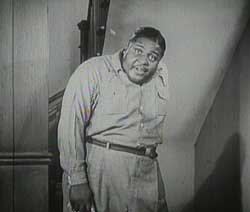 The story has him being fobbed off as Madame Deborah, a wealthy woman who was supposed to show up for a business meeting with an angel willing to back a musical variety show. When Deborah doesn't arrive when expected, to appease the other backer Bumpsie is convinced to play the part. The story has him being fobbed off as Madame Deborah, a wealthy woman who was supposed to show up for a business meeting with an angel willing to back a musical variety show. When Deborah doesn't arrive when expected, to appease the other backer Bumpsie is convinced to play the part.
Despite that he's wildly unconvincing in drag, the wealthy backer falls in love with her at first sight, being a rather childlike fellow easily impressed. Meanwhile the landlord begins competing for her attention not with such honest affection but because he believes the ugly old gal is wealthy.
This has goofy charm right out of the gate, but it works so well because the two fat guys, innocent Mr. Collins & greedy landlord, are played respectively by Allen Jackson & Warren Patterson.
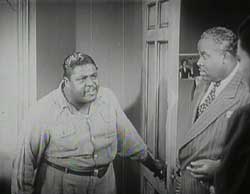 As "Patterson & Jackson" these two guys were a top comedy team though their fame did not much spill out of the African American community. As "Patterson & Jackson" these two guys were a top comedy team though their fame did not much spill out of the African American community.
They have a couple spectacular moments of song & dance in Killer Diller (1949), including a comedic impersonation of the Ink Spots. "Of course there's only two of us," said Al, "but we weigh as much as all of them." They also made a couple of lovely soundies including Mama, I Wanna Make Rhythm (1943).
Oddly, except for a momentary private moment of tapdancing for Patterson, they don't do any of their song & dance routines in Boy! What a Girl. But they dominate the story as rivals for the fake Madame Deborah, & are as funny as any comedy duo of the era you can imagine, including such giants as Abbott & Costello.
The "real" Madame Deborah is secretly nearby, a woman with a huge sense of humor who is not the least bit offended by the goings-on, but remains incognito to see how much whimsical trouble everybody can get into. She even befriends the fake Madame Deborah, & they have an absolutely wonderful buddy-buddy friendship, smoking cigars together & laughing their hearts out.
This delightful actress is Sybil Lewis, one of the most skillful women to act in the "race films" of the '40s, who just never turns in a bad role. She's been compared to Bette Davis in her prime, & I think that's fair.
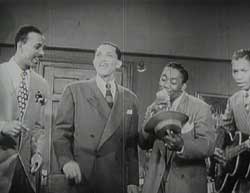 But as was often the case in the better black-cast films, the music's the thing, the comedy's just a bonus. And at the rent party upstairs, we'll soon be listening to the vocal stylings of Ivory "Deek" Watson and the Brown Dots.
But as was often the case in the better black-cast films, the music's the thing, the comedy's just a bonus. And at the rent party upstairs, we'll soon be listening to the vocal stylings of Ivory "Deek" Watson and the Brown Dots.
Deek the comedic singer had left the original Ink Spots a couple years earlier specifically so he'd be able to do some of his comic shtick as well as use his great voice.
The Brown Dots in addition to second tenor Deek consisted of lead tenor Jimmie Nabbie (who had replaced Joe King from their first recordings), bass Jimmy Gordon, & Baritone William "Pat" Best. The Brown Dots' best known song, written by Pat Best & recorded while Joe King was still with the group, was "For Sentimental Reasons," which became a standard, covered by everyone from Nat King Cole to James Brown.
Not long after Boy! What a Girl wrapped, the guys split away from Deek, found a new second tenor, & became The Four Tunes. Deek wasn't easy to get along with, but you'd never know it from his humor while singing "Just in Case You Change Your Mind," composed by Harry Patterson, Melvin Bell & Deek Watson.
It's performed in a very close imitation of the Ink Spots, but with the addition of Deek mugging & camping it up, without injury to the song's beauty & harmonies:
"Just in case you change your mind/ Though it takes a year or more/ I'll be hanging round your door/ Just in case you change your mind..."
They also perform the splendid jump-jazz number "Satchel Mouth Baby," the lyrics for which run:
"That's my baby. We'll have a lot of fun yes a lot of fun/ Cuz baby, you're the cutest one, one, one/ You're so sweet, you're so neat/ When you're walking down the street/ Everybody says baby, you're the cutest one/
"You're so heavenly/ What a break for me/ Baby can't you see/ I'm in love, love, love/ That's my baby/ We could have a lot of fun yes a lot of fun/ Cuz baby, you're the cutest one, one, one..."
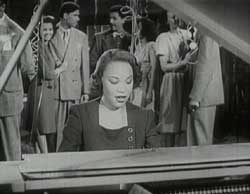 Mary Lou Williams (one of Duke Ellington's arrangers & a superb composer & pianist) wrote "Stachel Mouth Baby."
Mary Lou Williams (one of Duke Ellington's arrangers & a superb composer & pianist) wrote "Stachel Mouth Baby."
For some odd reason, the mistake is often made that Mary Lou's playing piano with the Slam Stewart Trio on their instrumental "Slamboree" & the song "Oh Me Oh My Oh Gosh" with Slam doing the vocal. But that pianist is Beryl Booker.
We do get an uncredited performance by Mary Lou, however. She's that classy babe of a pianist who plays a solo in a classical music style at the rooftop party.
She was actually a master of stride & it's curious she chose this film to show her classical skills, but that's something Eubie Blake also liked to do, from justified pride of ability.
A story goes that when she was only fifteen years old she was jamming at three in the morning with McKinney's Cotton Pickers at the Harlem Rhythm Club, when in walked Louis Armstrong who stood thunderstruck. When she was finished, he walked over to her piano, lifted her from her seat, & gave her a big kiss.
Mary Lou's legacy is in her music, but she had also spent a lot of her life nurturing talent in the black community. This legacy, too, continues through the Mary Lou Williams Black Cultural Center at Duke University, which focuses on appreciation of the artistic & historical contributions to American society by "people of the African Diaspora."
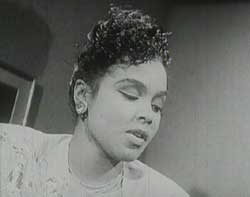 There's also some fine jitterbugging at the rent part, courtesy of the Harlemaniacs (sometimes mistakenly "corrected" as two words, Harlem Maniacs, which was the name of an earlier group). The Harlemaniacs were better known as the International Jitterbugs.
There's also some fine jitterbugging at the rent part, courtesy of the Harlemaniacs (sometimes mistakenly "corrected" as two words, Harlem Maniacs, which was the name of an earlier group). The Harlemaniacs were better known as the International Jitterbugs.
They were mostly dancers from Whitey's Lindy Hoppers. At least six members of this troupe are seen dancing to performances of "I Just Refuse to Sing the Blues," "Just in Case You Change Your Mind" & "Satchel Mouth Baby," playing random attendees at the rent party.
That's Ann Cornell singing the Walter Bishop composition "I Just Refuse to Sing the Blues," in a style reminiscent of Billie Holiday:
"I just refuse to sing the blues/ It's not for me/ I ought to cry but what should I/ It's misery/ If you don't want me it's up to you/ I'll just have to look around for somebody new..."
Cornell recorded with Sterling Records & Bandwagon Records in the 1940s, but never achieved the fame her talent merited, so that her appearance in Boy! What a Girl is today the only chance to see her perform.
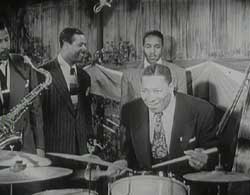 Big Sid Catlett & His Band aren't seen nearly enough in the film, but when they do get their moment, they shine. In his band are Benny Morton (trombone), Don Stovall (alto sax), Eddie "Lockjaw" Davis (tenor sax), Ram Ramirez (piano), Johnny Simmons (bass) & Dick Vance (trumpet).
Big Sid Catlett & His Band aren't seen nearly enough in the film, but when they do get their moment, they shine. In his band are Benny Morton (trombone), Don Stovall (alto sax), Eddie "Lockjaw" Davis (tenor sax), Ram Ramirez (piano), Johnny Simmons (bass) & Dick Vance (trumpet).
Sid was the dummer for Louis Armstrong's All-Stars & with McKinney's Cotton Pickers, Fletcher Henderson, Don Redman, Eddie Condon, Benny Goodman, Teddy Wilson, & Lionel Hampton. The best bands wanted him.
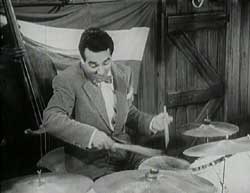 Yet in his key scene of fantastic drumming, he unexpectedly with surprising generosity turns his kit over to the film's only white performer, Gene Krupa, who said, "I wanna get some kicks with these sticks!" Yet in his key scene of fantastic drumming, he unexpectedly with surprising generosity turns his kit over to the film's only white performer, Gene Krupa, who said, "I wanna get some kicks with these sticks!"
Gene drums with Catlett's band very impressively, then leaves the film as swiftly as he appeared. Though not before telling Sid he'd have to return the favor by appearing in one of Gene's films someday.
Betti Mays does double-duty in the film, first of all sharing the position of leading-lady with Sheila Guyse as the sisters Cristola & Francine Cummings, love interests for the pair of leading men, Elwood Smith & Duke Williams as Jim & Harry, the guys who produce variety shows. The happy ending for the film is that these four form two couples headed for matrimony.
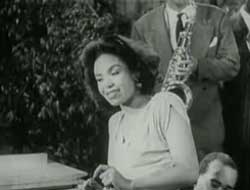 Betti's second duty was as singer. Backed by Big Sid Catlett's Band she sings "Crazy Riffin" written by Walter Fuller & Robert Brown, one of the most thrilling numbers among the film's universally fine choice of songs. Betti's second duty was as singer. Backed by Big Sid Catlett's Band she sings "Crazy Riffin" written by Walter Fuller & Robert Brown, one of the most thrilling numbers among the film's universally fine choice of songs.
It begins with a slow lead-in to the piano of Ram Ramirez: "The king of hi-de-ho one day/ Called out his band to play/ And when the band began to swing/ The king began to sing."
It then leaps into a jump-jazz beat beginning with a bit of scatting, "He sang rebop a bam, mo bobba rebop" before starting into the lyrics: "All of the hep cats in the land/ Heard it at a college band/ Crazy riffin is the thing/ Makes you wanna dance & sing/ Ah-ba-la-be, ah-bu-la-bah, boy that's crazy riffin..."
The musical break, which includes a great little sax solo, is framed by Betti scatting, then closing with a repeat of the primary lyrics. Lovely number!
In all, this is a dandy film & for the music one of my favorite black-cast films. It puzzles me that it has been dismissed as just-another of kind, when in fact it's great.
copyright © by Paghat the Ratgirl
|
